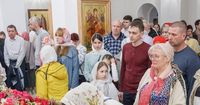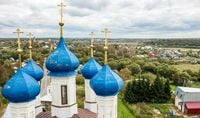Bright Week, a significant period for Orthodox Christians, begins on April 21, 2025, following the celebration of the Bright Resurrection of Christ on April 20. This week, also known as Paschal, Holy, or Bright Week, is marked by various unique liturgical and everyday traditions that extend the joy of Easter.
As the first week after Easter, Bright Week sets the tone for the entire forty-day celebration of the Resurrection of the Lord. While many may feel that the Easter festivities conclude on Resurrection Sunday, the Church encourages believers to prolong this joy significantly. The entire period leading up to the Ascension of the Lord (which falls on May 29, 2025) is considered Easter, with Bright Week holding a special place within this time, symbolizing a continuous day of celebration.
During Bright Week, church services take on a unique character. Daily Divine Liturgies are held, preceded by Paschal Hours, which repeat the main Easter hymn, "Christ is Risen." These hours are recommended as replacements for regular morning and evening prayers. After each liturgy, a cross procession occurs around the church, symbolizing the journey of the myrrh-bearing women to the Lord’s Tomb. Notably, the Royal Gates of the iconostasis remain open throughout the week, signifying the accessibility of the Heavenly Kingdom opened by Christ's Resurrection.
Bright Monday, known as Polivalny Monday, is characterized by a tradition where young men pour water on women they admire, symbolizing a playful spirit of joy and renewal. This custom serves as a reminder of the spiritual awakening that Easter represents. Women, on the other hand, traditionally visit friends and relatives, bringing baskets filled with Easter treats. It is a day filled with laughter and light-heartedness, where the act of dousing someone with water is done in jest.
On Tuesday, April 22, the theme of Bright Week continues with "Kupalische," a day when women dress in their finest outfits and visit loved ones, carrying baskets of Easter goodies. This day also holds special significance regarding water, believed to possess healing properties. According to tradition, if someone missed their morning prayer, they might be playfully splashed with cold water as a lighthearted reminder of the season's joyous spirit.
Each day of Bright Week carries its symbolism and customs. For instance, Wednesday is traditionally a day to commemorate martyrs, while Thursday is often viewed as a day for young couples to assess potential partners. Bright Friday, known as Forgiveness Day, involves visiting newlyweds, and it is customary for women to wash their faces with cold water, believed to preserve youth and beauty.
As the week progresses, the Church emphasizes the importance of maintaining a spirit of joy and kindness. It is advised that during Bright Week, believers refrain from quarrels, gossip, and negative thoughts. Instead, they are encouraged to engage in good deeds, show mercy, and express generosity, embodying the love that Easter represents.
In practical terms, the restrictions of Great Lent are lifted during Bright Week, allowing the consumption of meat, dairy products, and eggs. However, the Church advises against excesses, reminding the faithful that the focus should remain on spiritual joy rather than physical indulgence. The clergy emphasize that while fasting is not observed, it is crucial to maintain peace in one’s soul and to devote time to prayer and communion with loved ones.
Bright Week also establishes a unique atmosphere in churches. The clergy don red vestments, and the churches are adorned with flowers and Easter eggs, creating a vibrant and festive environment. Throughout the week, it is customary for congregants to greet each other with the words "Christ is Risen!" and respond with "Truly Risen!" This exchange fosters a sense of community and shared joy among believers.
On Saturday, the week concludes with a special service, and the Royal Gates are closed, marking the end of Bright Week. The faithful receive a special Easter bread known as artos, symbolizing the culmination of their celebrations. Following this, the next significant occasion is Fomin Week (Antipascha), popularly referred to as Red Hill, which allows for weddings and further celebrations.
Overall, Bright Week is a time for Orthodox Christians to reflect on the themes of resurrection, joy, and community. It encourages believers to extend their Easter celebrations through acts of kindness, spiritual engagement, and communal festivities. As the faithful gather in churches, partake in traditions, and share in the joy of the Resurrection, Bright Week serves as a reminder of the importance of love, mercy, and the enduring spirit of Easter.










